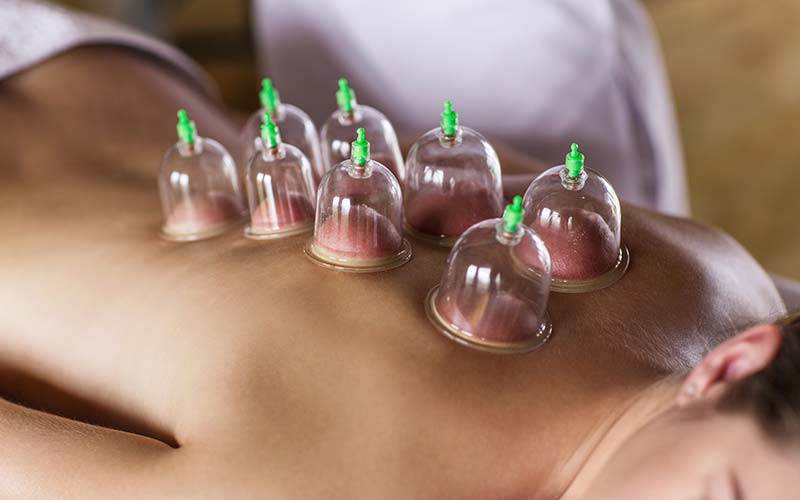
What is Myofascial Decompression (MFD)?
AKA “cupping,” MFD is an ancient technique used to improve angiogenesis to taut tissues.1 It lifts skin and muscle through negative pressure which causes blood to collect in the selected area to oxygenate and improve myofascial mobility.1
Therapeutic Indications
- MFD targets tight tissues, painful areas, restricted motions, scars, and postural issues.2
- The goal of MFD is to release soft tissue constriction, reorganize the soft tissues, restore movement, improve circulation, and improve your perception of pain.2
Different Approaches: Static vs. Dynamic vs. Active Movement
- Static: A passive cupping technique where cups are left on the body for a certain period of time.3
- Dynamic: A passive cupping technique where cups are placed on the body and moved.3
- Movement: An active cupping technique where cups are left on the body in conjunction with movement activity.4
The Effects of Static vs. Dynamic MFD on Hamstring Flexibility in a College-Aged Population: A Pilot Study
- This study indicated that both static and dynamic MFD is safe and effective at improving hamstring flexibility with no negative perceived effects. A dynamic application can improve flexibility and less ecchymosis compared to a static application. These findings offer clinicians additional effective techniques at improving hamstring flexibility.5
Effect of Cupping Therapy on Range of Motion, Pain Threshold, and Muscle Activity of the Hamstring Muscle Compared to Passive Stretching
- The findings of this study suggest that cupping therapy has as much positive effect on flexibility, pain threshold, and muscle contraction as passive stretching. Therefore, cupping therapy should be considered as another option to treat range of motion, pain, and muscle activity in the clinical field. It also can serve as another tool for patients who cannot conduct the stretching exercise.6
Cupping: A Novel Method of Soft-Tissue Release
- This article suggests that, compared to static methods, active and/or active assisted movement of the tissues while the cup is on may further assist the release of the interfaces between the soft-tissues such as skin, fascia, neural tissues, muscles, ligaments and tendons.7
- Further progression of this technique include dynamic movement of the cup with active movement of the patient, aka Tissue Distraction Release with Movement (TDR-WM).7
- Compared to various manual soft-tissue release techniques, TDR-WM may not only sometimes be more effective, but the technique is certainly easier on clinicians’ hands and thumbs.7
Summary
- MFD is an alternative intervention that can provide benefits similar to that of passive stretching and soft-tissue manipulation, including- improved local circulation and lymphatic flow, relaxed muscles, improved flexibility, scar tissue adhesion and trigger point release.7
- Different patient diagnoses indicate different cupping therapy approaches.
- Approaches can be clinically determined through the patient’s functional limitations and pain tolerance.
- Active cupping is a more aggressive means of treatment as it challenges the patient to actively engage and mobilize the underlying muscles. It helps to restore normal-tendon strength and flexibility, and joint range of motion.8
References
- MFD | Cup Therapy Myofascial Decompression Techniques. https://cuptherapy.com/news. Accessed November, 29, 2020.
- Myofasical Decompression. Western Medicine’s Cupping Treatment. www.theepochtimes.com. https://www.theepochtimes.com/myofascial-decompression-western-medicines-cupping-treatment_2149076.html. Published September 1, 2016. Accessed November 29, 2020.
- Cupping Therapy – Static & Dynamic Applications – Pure Nature Cures. Pure Nature Cures. https://purenaturecures.com/static-dynamic-mineral-cupping-therapy/. Accessed November 29, 2020.
- Curious about Cupping Therapy? Pivot Sport Medicine. http://pivotsmo.com/curious-about-cupping/. Accessed November 29, 2020.
- Xie J. THE EFFECTS OF STATIC VERSUS DYNAMIC MYOFASCIAL DECOMPRESSION ON HAMSTRING FLEXIBILITY IN A COLLEGE-AGED POPULATION: A PILOT STUDY. May 2017. https://repository.library.fresnostate.edu/bitstream/handle/10211.3/192494/Xie_scu_6050D_10421.pdf?sequence=1. Accessed November 29, 2020.
- Kim, Jaeeun& Cho. Ji-Eun & DO, Kwang-Sun & Lim, Seung-Yeop & Kim, Hee-Joong & Yim, Jongeun (2017). Effect of Cupping Therapy on Range of Motion, Pain Threshold, and Muscle Activity of the Hamstring Muscle Compared to Passive Stretching. Journal of the Korean Society of Physical Medicine. https://www.researchgate.net/publication/319567134_Effect_of_Cupping_Therapy_on_Range_of_Motion_Pain_Threshold_and_Muscle_Activity_of_the_Hamstring_Muscle_Compared_to_Passive_Stretching. Accessec November 29, 2020.
- Cupping: A Novel Method of Soft-Tissue Release. PHYSICAL THERAPY WEB. https://physicaltherapyweb.com/cupping-novel-method-soft-tissue-release/. Accessed November 29, 2020.
Von der Muhll A. AOM Professional. https://www.aomprofessional.com/active-suction-cupping-2/. Published 2018. Accessed November 29, 2020.

